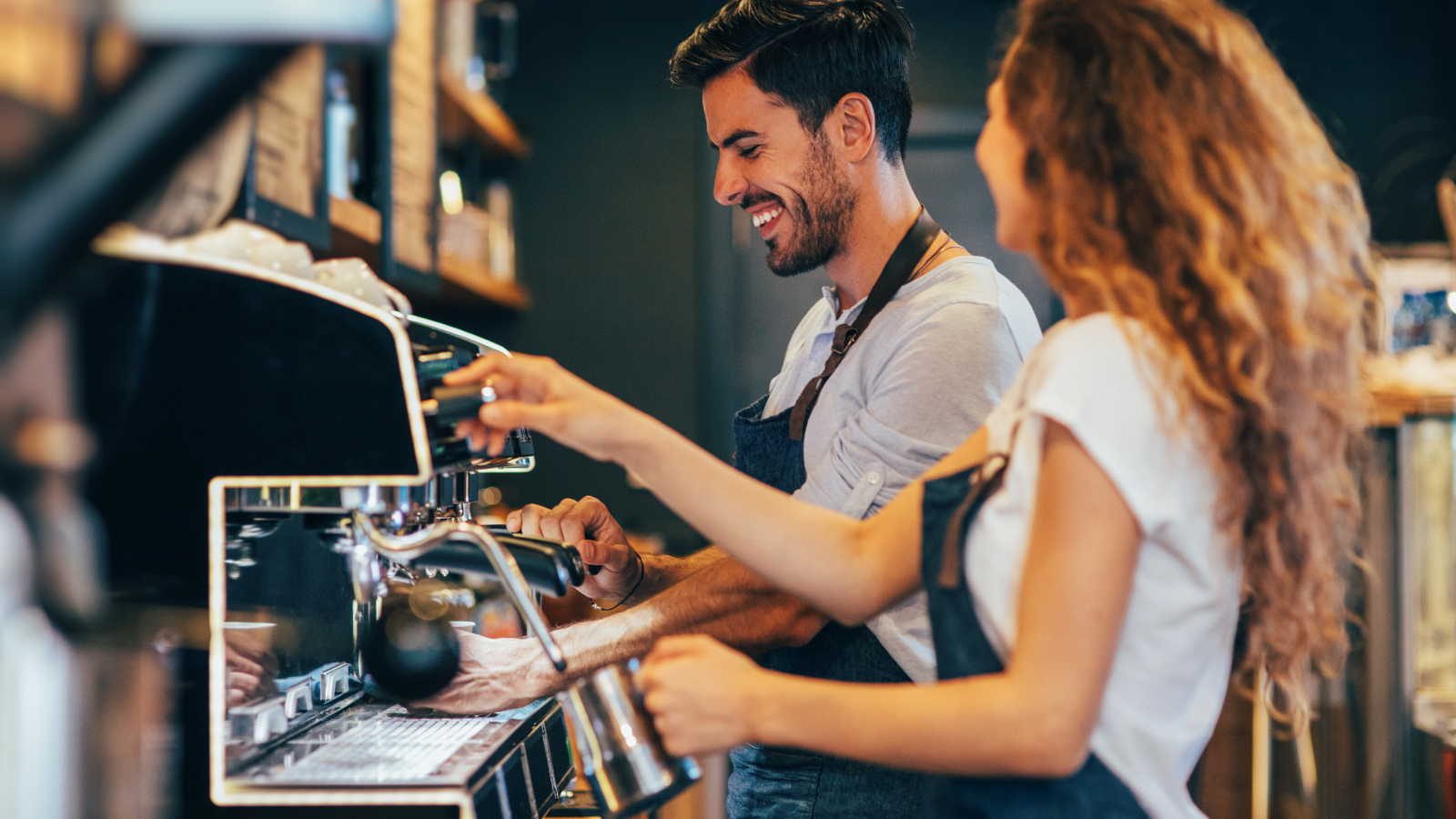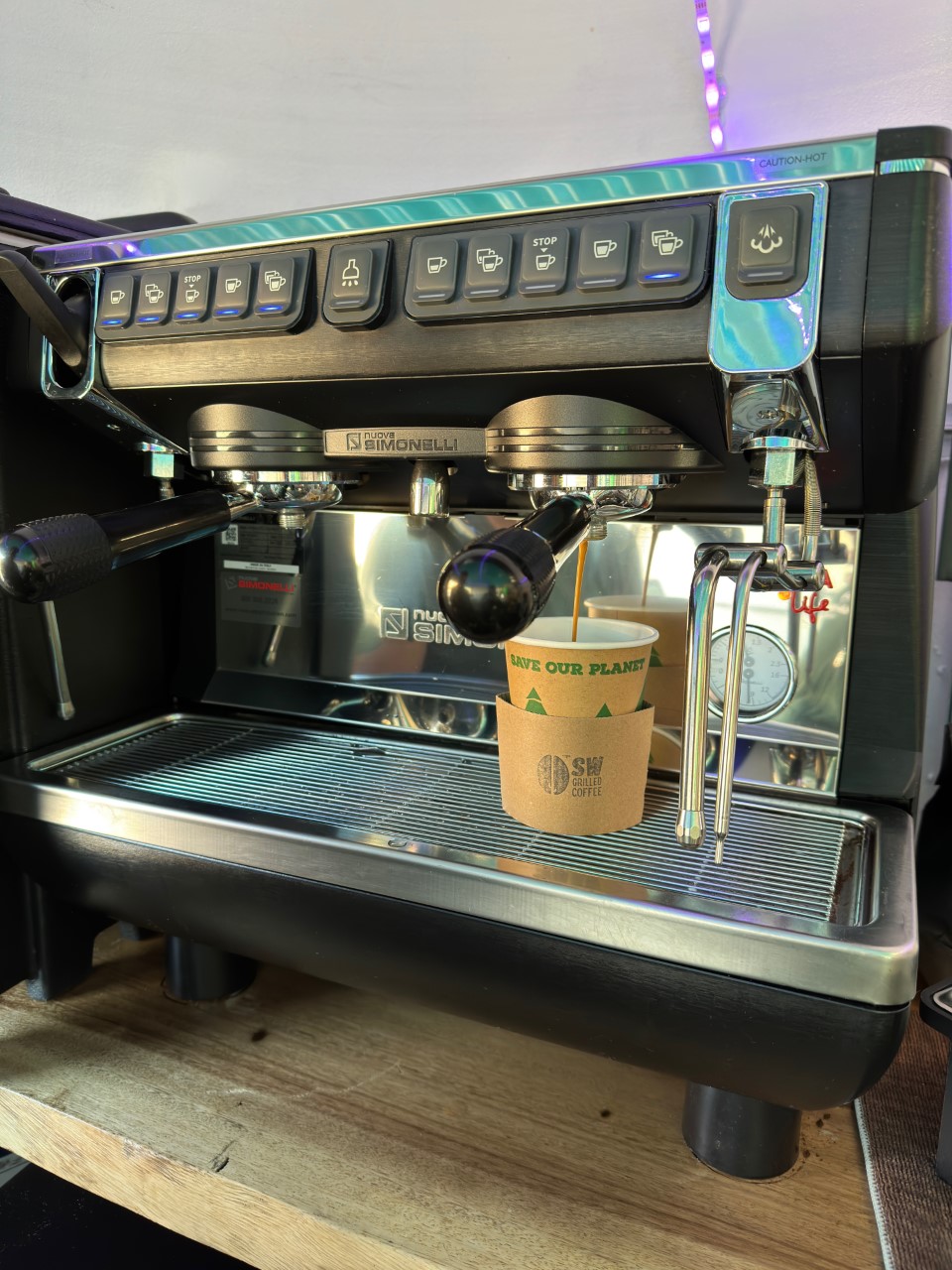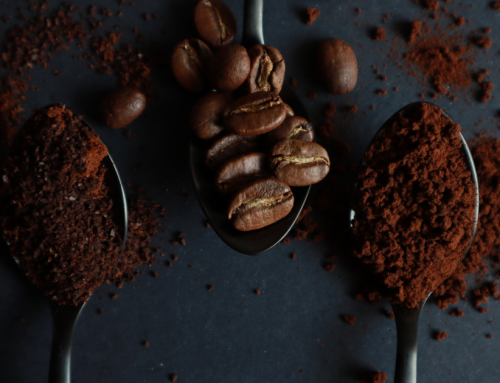Espresso has been around for over 100 years now and its popularity only appears to be increasing. According to the National Coffee Association of America, the consumption of espresso-based beverages has gone up by 50% in the past eight years. There’s also a burgeoning market for home espresso hobbyists, who are willing to spend significant sums of money on their own espresso machines and at home café setups.
The point I’m trying to make here is that espresso is not going away anytime soon. Coffee companies need to be equipped and informed on how to choose coffees for espresso and how to roast them accordingly.

Baristas pulling espresso shots | Img filadendron, Getty Images Signature
What are the best coffee beans for espresso?
You may have wondered: are there special coffees for espresso? Nope. Are coffee beans and espresso beans the same? Yep. They are both coffee beans. Are espresso and drip coffee different. Definitely! What’s the difference and what are the best coffee beans for espresso? For that, read on.
Any coffee can be made into espresso. There’s nothing special about an espresso blend from your favorite roaster aside from the fact that they labeled it as such. Sometimes they roast it a little longer. Usually, roasters will choose a specific coffee, or multiple coffees, in order to create a product that in their opinion is delicious as an espresso, or in an espresso-based beverage (like a latte or cappuccino).
When I was a roaster, some of the decisions I made for espresso were informed by efficiency, cost, and feasibility. Other times, depending on the overall goal of the roasting company, I experimented. This all comes down to knowing your customer base and defining your goals. Are you going for an old fashioned, thick, chocolatey shot of espresso to be used in a latte or mixed with sugar and cream? Are you trying to roast a coffee that would be super interesting on its own? Lastly, are you trying to get an espresso that is both agreeable in a milk-based beverage, but still interesting to a single-origin coffee connoisseur? I tend to split espresso into a few schools of thought this way.

Pulling shots of espresso in the Coffee Caboose at SW Grilled Coffee
Single Origin Espresso
Some cafes like having a single origin espresso option for customers who want a bit of an experience. For this, I recommend roasting the coffee how you normally would for a single origin. The goal is to magnify the inherent characteristics of this specific origin. I tended to roast these coffees for filter brewing, and it would likely come out as a brighter, more complex shot. The benefit is the fact that you don’t have to change anything about what you’re doing in production, and the coffee can be used for whatever you need. The only thing to be careful about is the fact that some more adventurous or experimental coffees may not taste great when added to milk-based drinks. You wouldn’t want to throw off a customer by serving an ultra-fermented experimental fruit process shot in a cappuccino, unless that’s exactly what they wanted.
Origins to I usually consider: Ethiopia, Kenya, Natural or Honey Processes. You want to select unique and interesting coffees that will shine through for their distinctive properties.
Classic – Join the dark side
When some people think of espresso, the thick, dark chocolate, muddy looking kind comes to mind. If your goal is a classic Italian espresso, this is a safe bet and there’s no secret when it comes to roasting: make it dark. At a certain point on the roast-level spectrum, whichever coffee you use will become uniform. You’ll be able to pull out the smoky, dark chocolatey, and maybe even tobacco forward notes that are best suited to milk, cream, or sugar.
Origins to consider: Lower grown coffees, Sumatra, Indonesia, Brazil. I tend to go for coffees that are milder, with less unique acidity work best in this style.

Getting ready to tamp down a shot of espresso | Luckyracoon – Getty Images
Mixing it up
Whenever choosing coffees for espresso, I always opted for something versatile. It was best to me when a coffee could stand on its own, but be agreeable enough to land in a latte or cappuccino. This also works well if you don’t want to, or don’t have time to blend. You can also pluck these coffees right out of the roastery and use them for whatever you need without taking any special measures. I would often choose a nice, washed Guatemalan green coffee, roast it as I would for 12oz bags, then send the rest to the café to be used as espresso. The coffee could be agreeable enough for both someone who wants a vanilla latte, and someone who wants a single origin shot.
Origins I’d recommend: Guatemala, Colombia, Peru, Costa Rica, Honduras
Espresso Blends
Many coffee-roasting companies create their own unique espresso blends. Blends usually combine a few select coffees that are chosen for their unique properties. You can accomplish a few things by blending. It’s great marketing to have a consistent espresso blend that your customers can always rely on, and it can be a good way to offload aging coffees from a production standpoint.
Blends are fun because they allow you to get creative and mix different origins, coffee varieties and even species of coffee with nearly infinite results. For instance, a roaster I once worked for would always make the espresso blend by combining a Sumatra for body, a Central for chocolaty or caramel notes, and an African component for some higher acidity.
The main thing to be wary about in blending is solubility. When you roast different coffees, they naturally have varying degrees of solubility due to origin, roast degree, and many other factors. If you’re blending coffees together that do not extract at the same rate, this can become problematic, or even magnified, when pulling a shot. There can be shots that taste both bitter and sour at the same time due to one coffee being over extracted, and the other being under extracted. This may be an issue with a black & tan type blend or combining too many different coffees from varying origins.

Espresso machine ready to pull shots | PPAMPicture – Getty Images Signature
Espresso Blend Ratios
Another question we often hear: how do you choose the ratios when blending coffees? Sometimes it’s as simple as what production allows, but other times it isn’t that obvious. I would always set up a cupping table with different percentages of each coffee blended together.
Example:
- Cup 1 is 25% Colombia, 75% Ethiopia.
- Cup 2 is 50% Colombia, 50% Ethiopia
- Cup 3 is 25% Colombia, 75% Ethiopia
This way, you can taste through the different blends and see which proportions and components work best. You can take note of the flavors that are shining through, and how balanced everything your roast is.
Coffee Review has a good write up on the topic, if you would like to read more on this subject.
Selecting Green Coffee Beans for Espresso
There are a few suggestions for origins that work with the different styles of espresso mentioned above. It’s important that the green coffee beans you buy are chosen for their unique properties. You may even select each coffee for a singular distinctive property.
We see a lot of classic espresso blends that combine washed south or central America with a natural Ethiopia. This combination gives you body, crema, chocolate, and caramel, with added jammy notes from the natural. It’s fun to mix and match and experiment.
Roasting Espresso
There are many schools of thought when it comes to roasting for espresso. The goal with any form of roasting is to make the coffee soluble enough for you to bring out all those delicious flavors, aromas, and nuances.
Many roasters will roast their espresso blends a little bit longer. This can help taper off the acidity and enhance the sweetness so that your espresso isn’t too bright. In my experience, roasting a bit longer, reduces your chance of pulling a suboptimal, overly acidic shot. Check the Perfect Daily Grind article on roasting for filter vs. espresso, which I will share with you here.
Summary
Coffee is a very personal thing. There’s no right or wrong way to blend or roast coffees for espresso. All that matters is that you and your customers enjoy it. However, it helps to have a basic set of principles and a goal in mind. From there, feel free to experiment.
Roast and enjoy!






